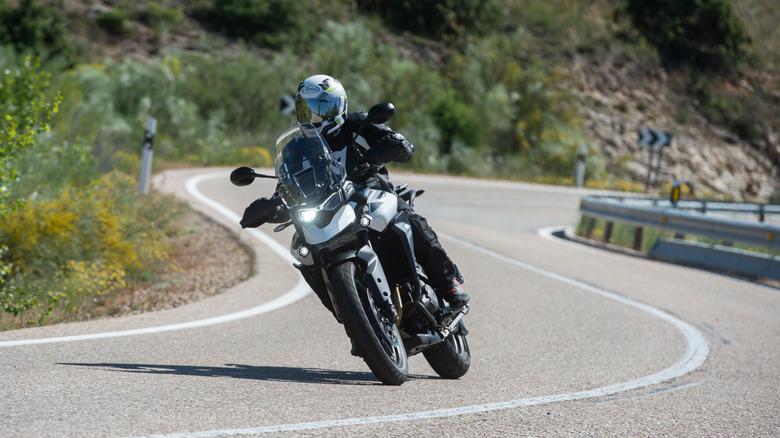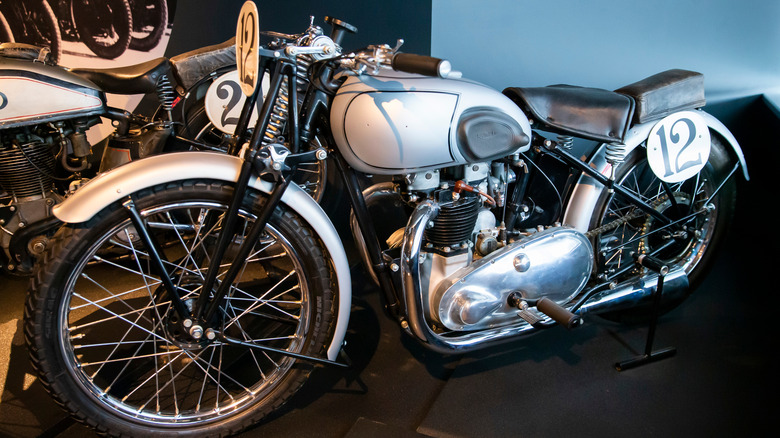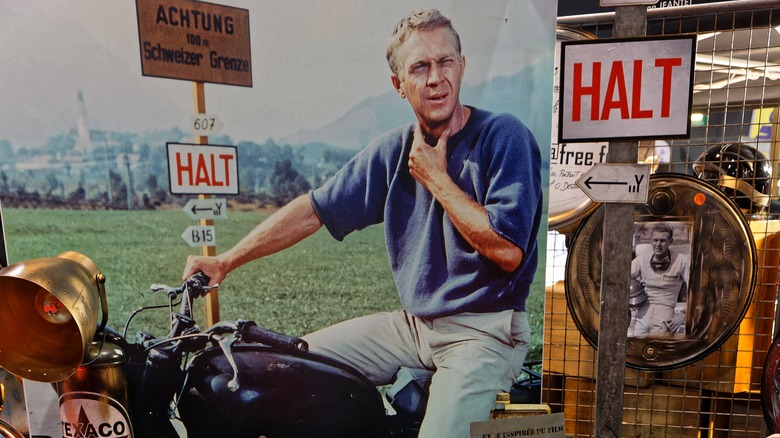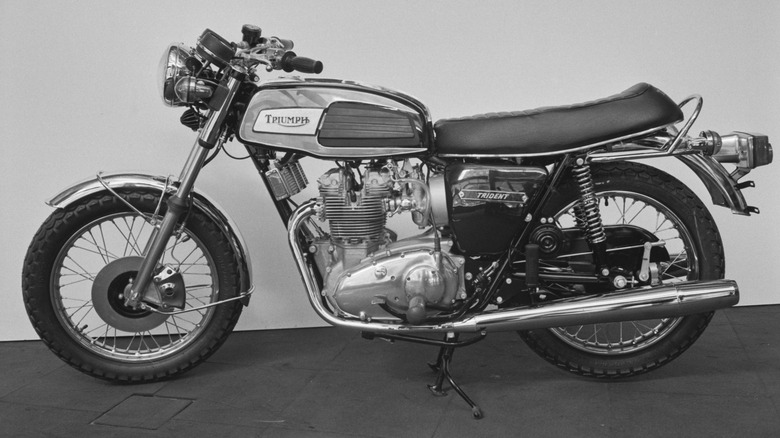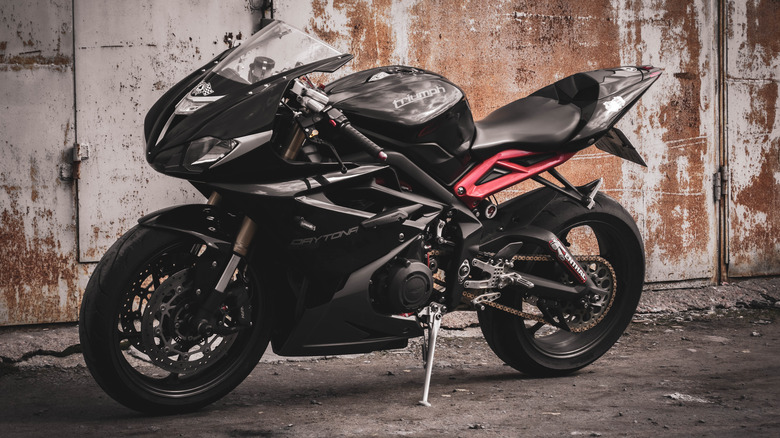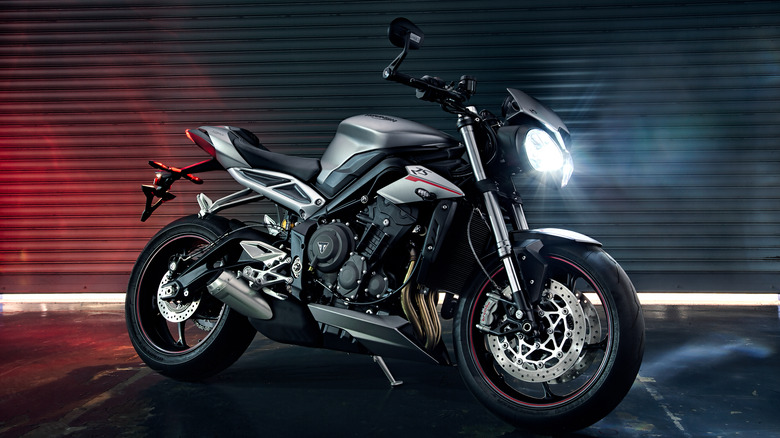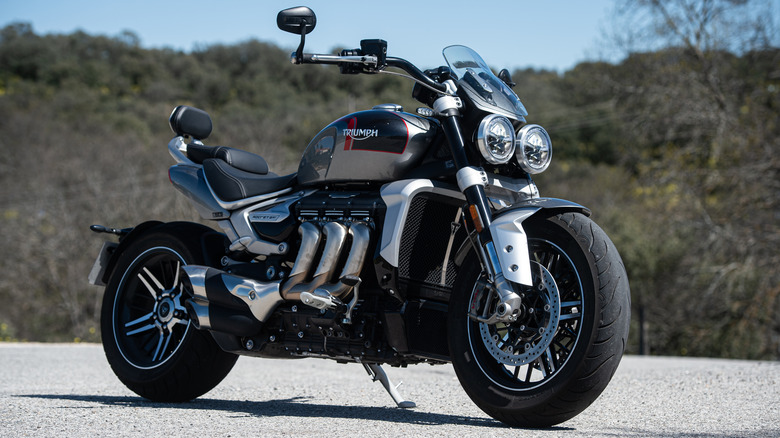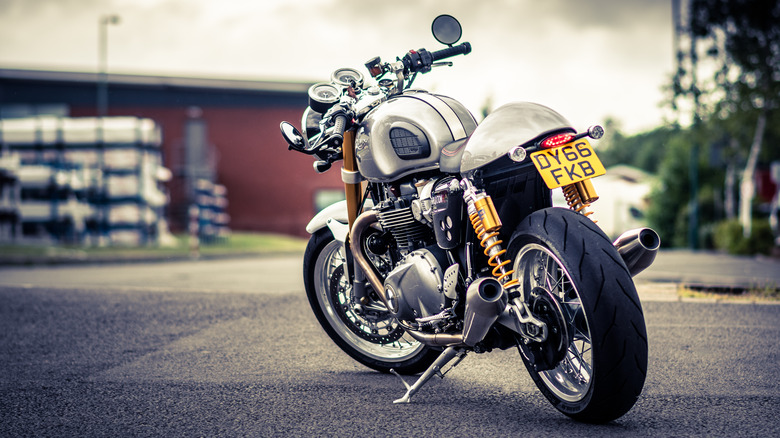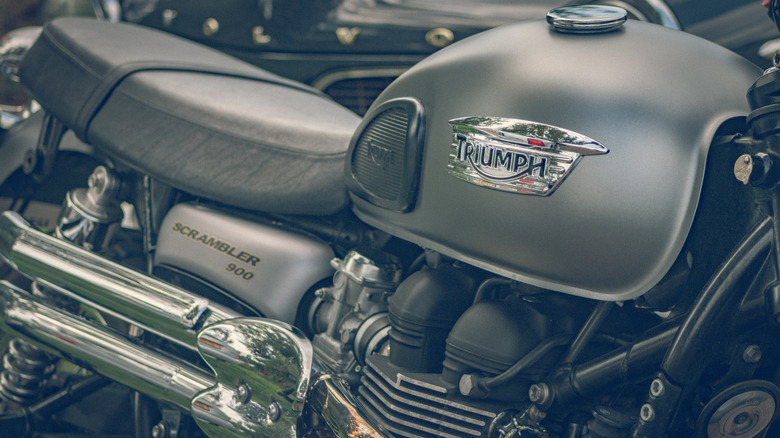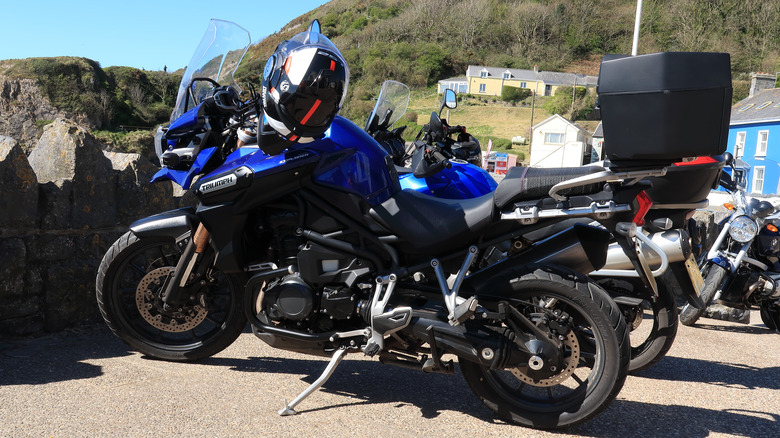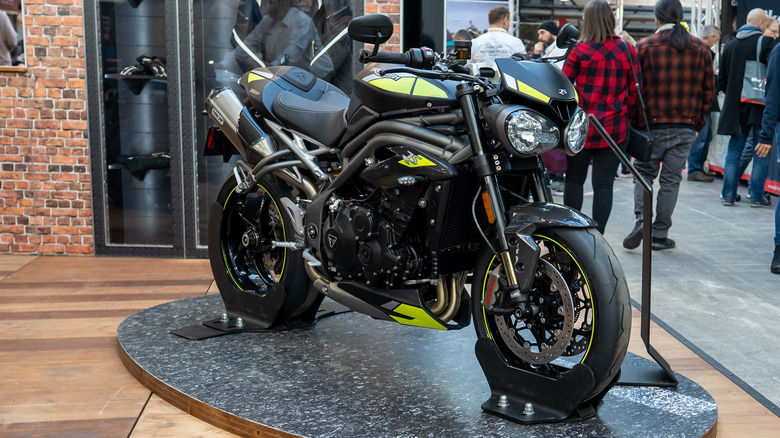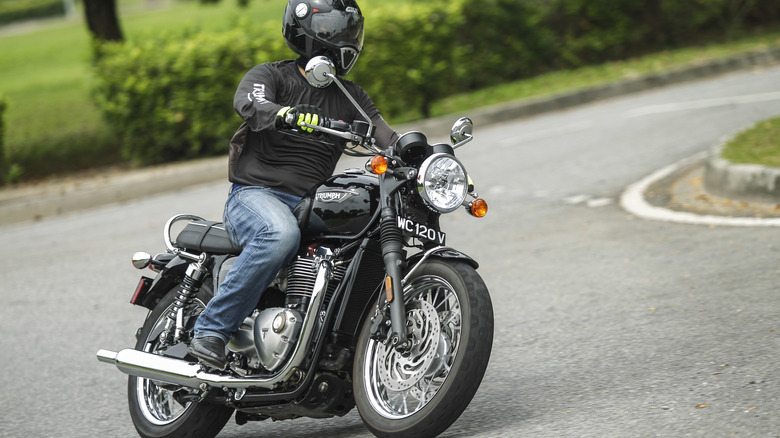The 11 Best Triumph Motorcycles Ever Made
Triumph has a rich heritage dating back over 100 years. As the U.K.'s most prominent manufacturer of motorcycles, it ranks among the best in the world for its products' build quality, rider experience, features, and aesthetic appeal. Ever since Marlon Brando rode his Triumph Thunderbird 6T across the silver screen in "The Wild One," the marque has cemented itself as an engineering icon and one of the coolest brands on two wheels.
Triumph is also notable for the wide selection of machines it creates. The product line ranges from high-powered adventure bikes, such as the Tiger 1200 Explorer, to racing bikes, such as the much-lauded Daytona 675, to off-roaders, including the Scrambler 900, to classic bikes, such as the Bonneville, to which the brand is most closely associated.
Metaphorically speaking, it hasn't always been smooth riding for Triumph. Established as an importer of sewing machines and bicycles by German industrialist Siegfried Bettmann, the first motorcycle rolled off the production line as far back as 1902. Triumph went on to enjoy great success, both commercially and competitively, before posting substantial financial losses and declaring bankruptcy in the late 1970s.
Fast forward to today, and a new era of Triumph. It was saved from the brink of obscurity by John Bloor in 1983, who established Triumph Motorcycles Limited and got to work redesigning old icons, such as the Bonneville, while simultaneously creating new machines to compete with the dominant U.S. and Japanese markets. As recorded in The Economist, the company went from strength to strength, and today, Triumph produces some of the world's most recognizable and coveted motorcycles. Here we look at 11 of the most iconic bikes the British brand has created over the years.
Triumph T100 Tiger
Triumph traditionally used the rather odd naming convention of the initial T, followed by the bike's declared top speed in miles per hour. Introduced in 1950, the Triumph T-100 Tiger was an elegant 33-horsepower, 498cc machine that was a hit with the motorcycling masses.
The addition of telescopic front forks made the T-100 tiger stand out from other post-war Triumph motorcycles. This modern suspension design was pivotal for the rider experience, with vastly improved handling and comfort.
The T-100 Tiger will be remembered as a precursor to the modern motorcycle, as it took the best elements of the wartime-era bikes and added some much-needed innovation. This ushered in a new era of motorcycle enthusiasts at a time of economic recovery when car ownership simply wasn't an option for many. By the time the first Bonneville rolled off the production line nine years later, the basic foundations for all motorcycles to come were laid, thanks, in no small part, to the T100 Tiger.
Triumph TR6 Trophy
Anyone who has seen the movie "The Great Escape" will be familiar with the Triumph TR6 Trophy, where Steve McQueen appears to effortlessly jump over a barbed wire fence on his trusty steed, having stolen it from the German military. Naturally, the Germans used their native motorcycles in the Second World War, but such was McQueen's love for the Triumph brand that his 1961 machine was sprayed black in a vain attempt to disguise it as a BMW.
The road-going TR6 Trophy was first released in 1956, while competitive versions were created purely for off-road and desert racing. These had 650cc engines and were issued with a detachable headlamp to be removed for the track. True to its name, the Trophy placed first in several competitions, and the "Desert Sled," as it became known, has since earned itself a place in motorcycle history as a star of both the silver screen and the off-road racing circuit.
Triumph Trident 750
The Triumph Trident was introduced in the early 1960s and was a cooperative project with the brand's parent company, BSA. It is noteworthy as being one of the first production superbikes, alongside some legendary Japanese models, such as the Honda 750-Four.
Triumph went back to the drawing board and designed the Trident 750 from the ground up. It was the first motorcycle to use the three-cylinder engine, for which Triumph is now famous, thanks to its Daytona, Street Triple, and Speed Triple creations. While in production, the bike was set to be a sensation and the fastest thing on two wheels, but this never happened. It was so long in production that by the time the first Trident 750 was offered for sale, Honda's 750-Four had already eclipsed it.
The original models also missed the mark concerning styling, with boxy, square fuel tanks and tapered mufflers that resembled ray guns. By the time the mid-1970s rolled around, the bike had been reimagined with a curved fuel tank and the newly-invented front disc brake, but, alas, it was too little too late. Even the release of the stunning 1975 Trident did little to boost sagging sales, heralding the start of the original Triumph Engineering Company's decline.
Triumph Daytona 675
The turn of this century was a pivotal time for Triumph. Having been reborn under Triumph Motorcycles Limited in 1983, the early 2000s saw stiff competition from overseas, especially the dominant Japanese market, with its impressive array of reliable and affordable high-performance sport bikes. Leading the pack were such legendary rides as the Honda FireBlade and Kawasaki Ninja, and Triumph's answer to these beasts from the east came in the form of the Daytona.
After a slew of performance and construction issues with previous Daytona models, which in one instance resulted in a factory recall, Triumph finally found its footing with the Daytona 675. This three-cylinder contender was less powerful than many of its contemporaries but it had an impressive top speed that belied its engine size and received many accolades on and off the race track. It was a real looker as well, with smooth lines and not overly-aggressive fairing, while the responsive nature of the engine and its anti-lock brakes and multiple rider modes made it a hit with road-going bikers.
Sadly, it was not to last. The Daytona 675 was pulled from the production line in 2016 due to the constraints of European emissions regulations, but it will be fondly remembered in the annals of Triumph racing history.
Triumph Street Triple
The Triumph Street Triple initially used the same highly-praised three-cylinder engine as the Daytona 675, albeit retuned to make it better-suited to road users, and has become progressively more powerful in later models. This "naked" bike is essentially a sports bike that has been stripped of its fairing, leaving us with a nimble, skeletal road rocket that is all frame and fuel tank.
Unlike its bigger brother, the Speed Triple, the Street Triple is lighter and more accessible to everyday riders, although it is no introvert. The latest model produces 121 horsepower, tops out at around 140 miles per hour, and is fitted with many of the features you find on other high-performance bikes. These include upside-down Showa forks, five riding modes, a 6-speed gearbox with a quick shifter, and a TFT display that gives riders access to all the bike's various configurations.
Looks-wise, the Street Triple doesn't disappoint. It has often been the movie producers' ride of choice to showcase their stars' (or stunt riders') riding skills, with Angelina Jolie being one example in the film "Salt".
Triumph Rocket 3
We're not really sure what Triumph was thinking when it created the Rocket 3, as it is quite unlike any motorcycle the Hinckley, U.K. firm has ever produced. Style-wise, this bike has more in common with the great American brands Harley-Davidson and Indian than it does any European or even Japanese marque. In short, this looks like something Batman would ride when the Batcycle is in the workshop.
If you are of the opinion that bigger is always better, then the Triumph Rocket 3, with its long wheelbase, wide frame, and body mass similar to that of a silverback gorilla, should be on your radar. Marketed as "the ultimate muscle roadster," the numbers speak for themselves. Its inline 2,500cc 3-cylinder engine delivers 221 Nm peak torque, more than any production motorcycle before. It also goes from 0-62 miles per hour in 2.73 seconds when pushed.
When it comes to features, the Rocket 3 is well-equipped. The rear wheel is shaft-driven and has a single-sided swingarm. It has double front disc brakes, as can be expected on a machine of this size, plus it has switchable ABS, front to back, as well as multiple riding modes and traction control. Its beautifully-imagined TFT display features all the usual instruments, such as a tachometer, speedometer, odometer, and gear indicator. It also includes a tire pressure gauge, ambient temperature meter, and GoPro controls, so you can show the folks back home precisely why it was worth remortgaging your house to buy a motorbike.
Triumph Thruxton 1200
The Thruxton 1200 is named after a 500-mile endurance race in England where Triumph won three trophies between 1958 and 1971, and it is a fitting name for a classically-styled café racer. These are stripped-down motorcycles that were traditionally raced from London cafés back in the Swinging Sixties, and they typically featured minimal fairing and instruments, solo saddles, and "clip-on" handlebars.
In keeping with this aesthetic, the Triumph Thruxton 1200 has all of the aforementioned classic qualities, but the bike is a truly modern machine. It has rider-assisting features, such as electronic riding modes, switchable ABS, and switchable traction control, so riders can opt for maximum safety or throw caution to the wind and feel a better connection with the road surface (hopefully not literally). Additionally, it has Showa BPF forks, a slick six-speed gearbox, and, of course, the high-torque, twin-cylinder 1,200cc engine that delivers 96 brake horsepower.
The Thruxton 1200 would be appreciated by those who yearn for the good old days of biking when motorcycles featured more chrome than fiberglass, and you did much of the maintenance yourself. This bike competently bridges the gap between classic and contemporary, delivering the best of both worlds as far as riding experience and timeless good looks are concerned.
Triumph Scrambler 900
Few motorcycle manufacturers would consider putting a sizeable 900cc engine on a dirt bike, but Triumph did, and the result is the Scrambler 900. However, what sounds like a crazy idea in principle works well in practice, and the consequent Frankenstein's Monster of motorcycle parts has proven highly popular with the biking public. So much so that they recently released an even larger version, the Scrambler 1200 XE, with, you guessed it, a 1,200cc engine onboard.
Since the 1960s, Triumph has experimented in the off-road segment with bikes like the T120 TT, which was essentially a Bonneville with knobby tires and a chopped exhaust. The Scrambler was introduced in 2006, and it is a much more dirt-oriented machine with its wire wheels, high ground clearance, and long-travel suspension. Perhaps the most striking feature of the Scrambler 900 (and subsequent versions) is its raised twin exhausts. These are aligned on a horizontal plane somewhere above the rider's knee, with the mufflers hovering near the top of the rear mudguard. This could be a convenient way to keep French fries warm while using saddle bags.
The Scrambler 900 has inspired much competition in the form of the Royal Enfield Himalayan, the Norton Atlas Ranger, and the Ducati Scrambler, but Triumph was the first out of the gate in 2006 with this iconic machine that is capable of traversing almost any surface imaginable.
Triumph Tiger Explorer 1200
One of the joys of motorcycling is going off the beaten track and visiting destinations that are otherwise impossible to reach on most other means of transport. The Triumph Tiger Explorer was designed with just this in mind; a premium adventure bike to compete with BMW's dominant GS series and Honda's Africa Twin.
Thanks to its lengthy 7.5-inch front suspension and 6.6-inch ground clearance, The Tiger Explorer can tackle terrains that many other large motorcycles cannot. Several other features add to its appeal, including its single-sided swing arm with 7.6 inches of travel, double front disc brakes, front and rear switchable ABS, LED lighting, and an LCD instrument panel. Its large 1,215cc engine puts out an impressive 141 horsepower and it has a top speed of 137 miles per hour when on a stable footing.
Of course, adventure bikes are not for everyone. The sheer size and weight of the machines in the premium adventure segment are enough to put some of the most seasoned riders off the idea of ownership, and even many Tiger Explorer owners might rarely, if ever, leave the tarmac to venture into the unknown. With that said, bikes like this are as happy on highway rides as on unpaved surfaces, while its upright seating position gives you a commanding view of the road ahead and does not leave you fatigued after long distances. Plus, if nothing else, you'll look really cool while riding one.
Triumph Speed Triple
As the name suggests, the Triumph Speed Triple is a favorite with speed demons worldwide. It is one of the original bikes produced in the "streetfighter" style, which describes a contemporary sport bike that has been stripped of its aerodynamic fairing. The other part of its name refers to the three-cylinder configuration that has been used on several Triumph models since the 1960s.
The Speed Triple was initially created in 750cc and 885cc versions, but subsequent generations have produced more powerful models to satisfy consumer demands. The most recent release, the Speed Triple 1200 RR, is a formidable brute of a machine that packs a racing-tuned 1,200cc engine into its relatively-lightweight 438-pound frame. True to form, it has maintained the naked styling, with only a small headlight cowl as a fairing.
The Speed Triple is far from practical. Those looking to take their partner for regular picnics, or are looking for a daily commuter bike, should probably consider another ride. However, for those seeking rollercoaster-like thrills and performance to match, this could be the bike for you; something perhaps best illustrated by Tom Cruise in Mission Impossible 2. His was a Speed Triple T509, notable for its exposed tubular frame and "bug-eyed" headlamps, and it seemed his impossible mission was to fire a gun with his left hand while operating a clutch simultaneously; a feat that he miraculously managed to achieve nonetheless.
Triumph Bonneville
Owned and loved by many notable people, from Bob Dylan to Jay Leno, the Triumph Bonneville has stood the test of time. It was first introduced in 1959 and is still in production, with scores of different incarnations built. Each subsequent model retained its vintage styling, helping the Bonneville continue its domination of the premium classic motorcycle segment.
Named after the Bonneville Salt Flats in Utah, where many speed records have been attempted over the years, the trusty Triumph's standard model has a 900cc parallel-twin engine. This air-cooled, fuel-injected block is known for being reliable and clean, having had its emissions lowered to comply with EU standards. While this is no road rocket, the Bonneville is capable of reaching speeds of 115 miles per hour, while its beefier cousin, the liquid-cooled T120, boasts a 1200cc engine and can muster speeds of up to 130mph for the not-so-feint-hearted.
As you can imagine, for a motorcycle that can trace its roots back to the mid-20th century, the Bonneville has plenty of character but few frills, which is a large part of its appeal. Those motorcyclists who like onboard gadgets or rider assist features like traction control will be disappointed. Instruments are kept to the bare minimum, with a simple tachymeter and speedometer on offer in dual analog dials, with the latter including a small LCD by way of a fuel gauge. What they can expect is excellent all-around performance, and the discernible connection to the road that lies at the very core of biking. It's hard to improve upon perfection, and in the Bonneville, Triumph found its winning formula early on.
